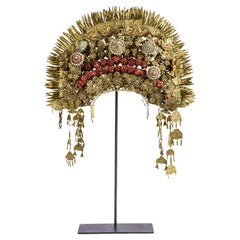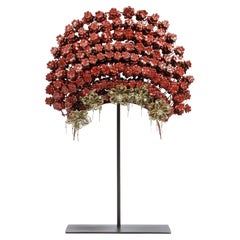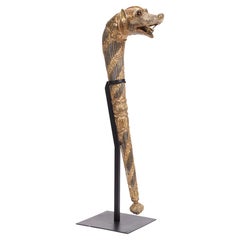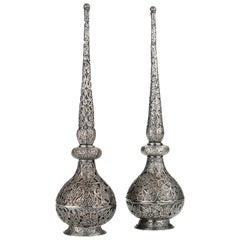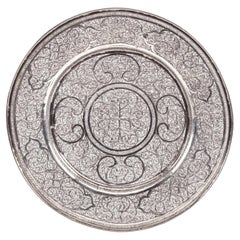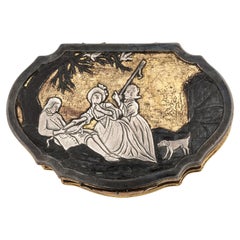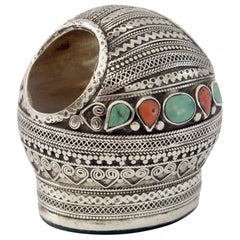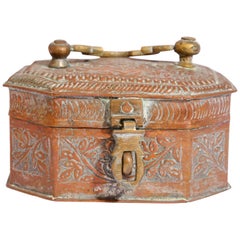Zebregs&Röell Metalwork
to
10
10
1
6
1
3
1
2
10
7
2
2
1
10
5
5
3
3
10
10
10
An elaborate Minangkabau gem-set brass floral wedding crown or 'Suntiang'
Located in Amsterdam, NL
An elaborate Minangkabau gem-set brass floral wedding crown or 'Suntiang'
West Sumatra, Minangkabau, probably 1st half 20th century
H. 66.5 cm (incl. stand)
Provenance: Private co...
Category
Mid-20th Century Indonesian Metalwork
Materials
Brass, Enamel
A superb Minangkabau red-enamelled and brass wedding crown or 'Suntiang'
Located in Amsterdam, NL
A Minangkabau red-enamelled and brass wedding crown or 'Suntiang'
A Minangkabau red-enamelled and brass wedding crown or 'Suntiang'West Sumatra, Minangkabau, probably 1st half 20th ...
Category
Mid-20th Century Indonesian Metalwork
Materials
Brass, Enamel
An Indian part-gilt silver-clad ceremonial sceptre or mace with a tiger’s head
Located in Amsterdam, NL
Northern India or Deccan, late 19th century
L. approx. 82 cm (excl. stand)
Provenance:
Private collection, United Kingdom
This remarkable gilt-silver soonta (ceremonial sceptre) also known as choba (ceremonial mace) with a tiger's head stands out as an unparalleled example. It has a wooden base, clad with thick sheet part-gilt silver and has fine details such as teeth and a curling tongue. Especially with the inlaid glass eyes, in combination with the grand sculptural design, it would have been integral to an Indian maharaja’s attire, known as lawajama in North India and biruthus in South India, as referenced by Jackson & Jaffer. They would symbolise authority, power, and sometimes an attribute of various deities, particularly those associated with strength or combat. For instance, the Hindu god Hanuman, known for his immense strength, is often depicted holding a mace (*chob* or gada in Sanskrit). Similarly, the god Vishnu and his avatar Krishna are also frequently depicted with a mace among their other attributes.
Courtiers would raise these sceptres wrapped in rich brocades, with the head visible, during processions, signalling their association with the monarch. Alongside fly-whisks and standards, they were indispensable in ceremonial parades, underscoring the ruler's prestige. Terlinden notes that a soonta berdar was tasked with carrying the sceptre. These individuals, proficient in courtly manners, played key roles during audiences, from managing entrances to introducing guests. Their esteemed position often earned them generous rewards, including land grants. See for a depiction of sceptres in use the top right of a painting in the collection of the V&A, titled Processional scene with Amar Singh, ruler of Thanjavur (Tanjore), and Sarabhoji, from circa 1797.
For a very comparable piece, but with an elephant’s head, see the collection of the Indian Museum, Kolkata. For other less similar examples, see the V&A Museum London.
Sources:
A. Jackson & A. Jaffer, Maharaja: The Splendour of India’s Royal Courts, London, V&A Publishing, 1999
Christiane Terlinden Serra, Mughal Silver...
Category
Antique Late 19th Century Indian Metalwork
Materials
Silver
Pair of Fine Islamic Silver Filigree Rosewater Sprinklers, Early 18th Century
Located in Amsterdam, NL
A pair of very fine silver filigree rosewater sprinklers
Possibly India, Karimnagar, early 18th century
Height 31.6 cm and 31.7 cm, weight 39...
Category
Antique Early 18th Century Indian Islamic Metalwork
Materials
Silver
Splendid and Heavy Late 17th Century Dutch-Colonial Silver Filigree Salver
Located in Amsterdam, NL
A splendid and heavy Dutch-colonial silver filigree salver
Indonesia, Batavia (Jakarta) or possibly Padang, West Sumatra, 2nd half 17th century
Diam. 22.9 cm
Weight 551 grams
This filigree-work was probably done by Chinese masters...
Category
Antique 17th Century Indonesian Dutch Colonial Metalwork
Materials
Silver
Rare Chinese Tonkin Ware Shakudo Sawasa Erotic Tobacco Box
Located in Amsterdam, NL
A ruyi-shaped Shakudo-style erotic tobacco or snuff box, relief-decorated with silvered applied figures
Possibly Jakarta (Batavia), first half 18th century
Measures: H. 2.2 x L. 12.1 x W. 8 cm
This box is very much in the Dutch taste, for the illustration is after a print with a legend reading “L’oiseau sans cage. Prenez, belle, mon oiseau. C’est le plus doux présent que je puisse vous faire. Pour les autres oiseaux, la cage d’ordinaire est une espèce de tombeau. Mais le mien semble prendre une nouvelle vie, Lorsqu’il sera dans la cage de mon aimable Silvie.” The erotic message is as clear as can be.
In Dutch culture the verb ‘vogelen’ (catching a bird) is another word for having sex and a bird escaping from his cage indicates loss of chastity. The lady with the bare breasts, while making the sign of sealed lips to the lady behind her, who is pointing towards heaven, seems to be caressing the bird held in the sleeping man’s groin. 17th century Dutch pictures...
Category
Antique Early 18th Century Chinese Chinese Export Metalwork
Materials
Gold, Silver, Bronze
Fabulous Indonesian Yogya-Silver Plate
Located in Amsterdam, NL
An Indonesian Yogya-silver plate
Yogyakarta or Kotagede, 1935-1940, marked, (alloy) 800 and maker’s mark PH (Prawirohardjo, act. from 1935)
Diam. 27.2 cm Weight 454 grams
Th...
Category
Early 20th Century Indonesian Art Deco Sterling Silver
Materials
Silver
Dutch Colonial Silver Dish with the Von Pfeffel Coat-of-arms, 17th Century
Located in Amsterdam, NL
An unusual Indonesian lobbed silver dish
Jakarta (Batavia) or Coromandel coast, third quarter 17th century, apparently unmarked
The eight lobbed dish exuberantly decorated with floral motifs, with the middle section replaced, consisting of indistinctly marked German silver from the early 19th century, bearing the coat-of-arms of the Von Pfeffel family.
Diam. 30.5 cm
Weight 461 grams
Note:
Lobbed silver dishes with exuberant floral decorations were characteristic of the decorative arts in the Netherlands in the first half of the 17th century. This style of floral decoration was adopted by silversmiths as well as by furniture makers working on the Coromandel Coast and in Batavia, often by workers who had fled the Coromandel Coast because of war and famine. In Batavia this style was known as “Custwerck” (work from the Bengal coast).
These lobbed dishes are seldom marked. Only after 1667 the use of the town mark became obligatory in Batavia but only for silver made in Batavia not for silver imported in Batavia from other VOC settlements. The engraved coat of arms in the centre is a replacement of the original centre.
The coat of arms can be identified as those of Christian Hubert von Pfeffel (1765- 1834). As a diplomat, statesman, ambassador of Bavaria in London and Saxony and councillor to the King of Bavaria, he was made “Freiherr” in 1828 and since then used this coat of arms. His son Karl Maximilian Friederich Hubert Freiherr von Pfeffel (1811-1890) in 1836 married Karoline Adelheid Pauline von Rottenburg (1805-1872), the natural daughter of Prins Paul von Württemberg (1785-1852) and his mistress Margrethe Porth. Paul was the jounger brother of the King Wilhelm I of Württemberg (1781-1864). The heraldic motto of the von Pfeffels Vur Schande habe den Huot means as much as “Beware of Shame”. Christian Hubert Theodoor Marie Karl von Pfeffel Karl Maximilian’s grandson was the last male in the von Pfeffel line. His daughter, Marie Louise (Paris in 1882 - Cornwall 1944), born and grown-up in France, changed her name in de Pfeffel. She was the great grandmother of Boris Alexander de Pfeffel Johnson, the present British Secretary of State. None of the members of the von Pfeffel family had any direct links with the Dutch East Indies but indirectly by way of the Royal House of Württemberg they did.
Sophia Frederika Mathilda von Württemberg (1818-1877), daughter of Wilhelm I King of Württemberg, in 1839 married Willem III...
Category
Antique Late 17th Century Indonesian Dutch Colonial Sterling Silver
Materials
Silver
Rare Chinese Tonkin Ware Cup-and-Saucer, Early 18th Century
Located in Amsterdam, NL
A Chinese made tonkin ware gilt- and lacquer cup and saucer
China or Japan, Chinese artisans, early 18th century
The black-lacquered cup with gilt handles in the shape of sculptured chrysanthemums and a lobbed edge decorated with gilt engraved border, with a gilt foot-ring that fits into the saucer ring, with two cartouches showing partly undercut gilt relief trees and birds on a gilt granulated background, black lacquered bracket-lobed edge, depicting gilt engraved peony scrolls and three cartouches decorated with high relief gilt trees and birds on a gilt granulated background, the centre with engraved chrysanthemum, enclosed by a raised ring upon which the cup fits, around which a circular panel decorated with high gilt relief trees, flowers, birds and a butterfly on a gilt granulated background.
Measures: Cup: H. 5.7 x W. 8.5 cm
Saucer: Diameter 13 cm
Provenance:
Collection Felix Schäfer
Note:
The decoration of the cup and saucer is identical to the slightly smaller cup and saucer...
Category
Antique Early 18th Century Chinese Chinese Export Metalwork
Materials
Other
Fine Indian Silver Filigree Casket with Hinged Cover, 18th Century
Located in Amsterdam, NL
A pair of very fine silver filigree rosewater sprinklers
Possibly India, Karimnagar, early 18th century
Measures: Height 31.6 cm and 31.7 cm,...
Category
Antique 18th Century Indian Metalwork
Materials
Silver
Related Items
Middle Eastern Large Antique Silver Gem Set Intaglio Seal Ring
Located in Bishop's Stortford, Hertfordshire
An exceptional and large antique Middle Eastern regal gem set silver intaglio collectors seal ring dating from circa 1900. This large and heavy man’s ring is handcrafted with wonderf...
Category
Antique Early 1900s Afghan Other Metalwork
Materials
Silver
Handcrafted Antique Tinned Copper Metal Betel Box, India
Located in North Hollywood, CA
Beautiful handcrafted antique tinned copper decorative octagonal betel box with with lid, handle and brass latch.
The metal is delicately and int...
Category
Early 20th Century Indian Folk Art Decorative Boxes
Materials
Brass, Copper, Tin
Indian Antique Large Ceremonial Hand Crafted Copper Yoni
Located in Bishop's Stortford, Hertfordshire
A large and rare antique Indian copper Yoni Shiva Lingam Ceremonial water Vessel dating from the 19th century. The Yoni represents the Hindu godd...
Category
Antique 19th Century Indian Other Metalwork
Materials
Copper
Chinese Export Silver Dragon Spoon by Wang Hing & Co., Late 19th Century
By Wang Hing & Co.
Located in Austin, TX
A very fine and charming Chinese export silver spoon in the form of a dragon, by Wang Hing & Co., Qing Dynasty, late 19th century, China.
...
Category
Antique 1890s Chinese Chinese Export Metalwork
Materials
Silver
$1,200
H 0.88 in W 5 in D 1 in
Chinese Lattice Top Incense Box, c. 1850
Located in Chicago, IL
This slender metal container is a 19th-century white brass incense burner, used for storing and burning incense sticks. The small box has a rectangular form and a removable sliding t...
Category
Antique Mid-19th Century Chinese Qing Metalwork
Materials
Brass
Indian Mughal Style Gem-Set Gilt Brass Snuff Box in Elephant Shape
Located in North Hollywood, CA
Vintage gilt brass lidded trinket snuff box with red and turquoise stone inlaid in the form of an elephant with trump up.
Vintage Indian Mughal style metal brass and set with dozens...
Category
Mid-20th Century Indian Anglo Raj Metalwork
Materials
Stone, Metal, Brass
Chinese White Brass Happiness Brazier, c. 1850
Located in Chicago, IL
Filled with burning coals, this petite 19th-century brass brazier once warmed the hands of a well-to-do person on a cold winter's night in northern China. The brazier is crafted of white brass in a rectangular form, complete with a hinged handle and an intricately pierced lid with a chrysanthemum pattern. The exterior is etched with a pattern of golden coins...
Category
Antique Mid-19th Century Chinese Qing Metalwork
Materials
Brass
Silver gold gilt Persian bib necklace with turquoise Middle Eastern Antiques
Located in London, GB
Silver gold gilt Persian bib necklace with turquoise Middle Eastern Antiques
A Highly detailed gold gilt metal Persian bib necklace influenced by the ancient style with turquoise and...
Category
Early 20th Century Persian Collectible Jewelry
Materials
Silver
$545
H 3.94 in W 5.91 in D 1.97 in
Antique Islamic Brass Bowl Fine Metalwork Hand Etched Bowl
Located in North Hollywood, CA
Antique Middle Eastern Islamic art Moorish brass bowl engraved with Thuluth Arabic calligraphy.The polished brass bowl is profusely chased with vines and vegetal motifs and inscribed with Islamic verses of the Holly Koran.This bowl has been professionally cleaned and polished.Measures: Diameter 7.25" x 4" height Mouth opening: 5".Great Middle Eastern brass metalwork decorative Islamic art objects.Handcrafted Moorish hand-etched Islamic metal brass bowl.Engraved, incised and hammered with very fine Arabic Islamic calligraphy writing and geometric designs on brass vessel.Very Intricate fine Middle eastern Moorish Islamic Art metalwork, museum quality artwork.Late 19th Century.Date of Manufacture: Circa 1880.Condition: Wear consistent with age and use.
Islamic brass metalwork is an intricate and beautiful form of art that originated in the Islamic world. It encompasses a wide range of decorative objects made from brass or other metals such as copper, bronze, and silver. Brass trays, in particular, are highly regarded for their craftsmanship and intricate designs.
Islamic brass metalwork has a rich history that dates back to the early Islamic period, with its roots in the metalworking traditions of ancient civilizations such as the Persians, Greeks, and Romans. However, Islamic artisans developed their own unique styles and techniques, blending elements from various cultures and creating distinctive motifs that reflected Islamic aesthetics and religious beliefs.
The process of creating brass trays involves several steps, each requiring specialized skills. Here is a general overview of the traditional techniques involved:
1) Design: A skilled artist or calligrapher creates the design for the brass object. Islamic brass metalwork often incorporates intricate geometric patterns, arabesques, floral motifs, and calligraphy inspired by Quranic verses or poetry.
2) Metalworking: The object is typically made from a sheet of brass or another metal. The metal is cut into the desired shape and then hammered or pressed to create the object. Traditional techniques such as repoussé (hammering from the reverse side) or chasing (hammering on the front side) may be employed to shape the metal.
3) Engraving: The surface of the metal is often decorated with intricate engravings or etchings. Skilled artisans use chisels, gravers, or other specialized tools to create fine details and elaborate patterns.
4) Filigree and Inlay: Some brass trays feature additional decorative elements such as filigree or inlay work. Filigree involves shaping thin wires of brass into delicate patterns and soldering them onto the tray's surface. Inlay work, on the other hand, involves embedding contrasting materials such as silver or copper into the brass, creating intricate designs.
5) Surface Treatment: After the main decorative work is complete, the tray may undergo surface treatments to enhance its appearance. This can include processes like polishing, buffing, or applying various chemical patinas to create an aged or oxidized effect.
While this bowl has certainly witnessed the passage of time, it remains in remarkably good condition, with only minor signs of age that add character to its appearance. The patina on the brass enhances its antique allure, making it a truly authentic and captivating collectible.
Arabic Calligraphy: The Arabic writing on the bowl is a work of art in itself. The calligraphy showcases the mastery of the scribe's hand, with flowing curves and intricate details that form an elegant script. The script may include Quranic verses, blessings, or poetic verses, depending on the bowl's origin and purpose. The inscriptions are not only visually striking but also carry profound meaning, making this bowl a beautiful representation of Islamic heritage.
Intricate Patterns: In addition to the Arabic calligraphy, the bowl features intricate geometric patterns and motifs that further enhance its visual appeal. These patterns are a hallmark of Islamic art and reflect the mathematical precision and artistic creativity that defined Islamic craftsmanship.
This antique Islamic brass bowl...
Category
Antique 19th Century Turkish Islamic Metalwork
Materials
Brass
Chinese Canton Enamel Round Stacking Boxes and Cover, circa 1900, China
Located in Austin, TX
An absolutely lovely Chinese export pink Canton enamel round stacking box and cover, late Qing Dynasty, circa 1900, China.
The circular stacking box consists of a bowl form base, ...
Category
Antique Early 1900s Chinese Qing Decorative Boxes
Materials
Copper, Enamel
Unusual Large Antique Brass Stick Or Umbrella Stand
Located in Ipswich, GB
Unusual Large Antique Brass Stick Or Umbrella Stand, circular in shape and decorated with shells, flowers and leaves.
Category
Early 20th Century Metalwork
Materials
Brass
Rare Japanese Red Birds Cloisonne Enamel Censer Koro
Located in Long Island City, NY
A rare antique Japanese late Meiji Era tripod and covered enamel copper censer. Circa: late 19th century to early 20th century. The sphere form censer koro is enameled with polychrom...
Category
Antique Late 19th Century Japanese Meiji Metalwork
Materials
Copper, Enamel
